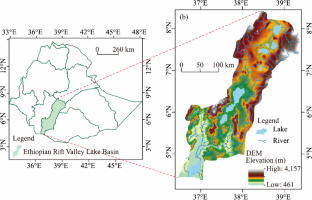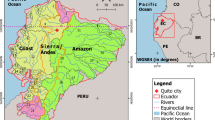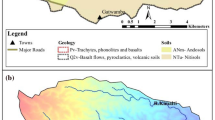Abstract
Soil erodibility (K) is an essential factor for erosion prediction, conservation planning and assessment of sediment-related environmental problems. K estimation methods have been developed in many soil erosion and water quality models, which are developed for soil data-rich areas and pose a challenge for areas with limited data. Unlike others, using the erosion productivity impact calculator (EPIC) model, the required soil parameters for calculating K can be extracted from the Food and Agricultural Organization (FAO) world database. To verify the FAO soil database and develop an alternative K method (KET) by mimicking the equation of K used in the EPIC model, we collected 203 soil samples from different soil units in the Ethiopian Rift Valley Lake Basin (ERVLB). Unlike the K of EPIC model, KET is developed based on the physical properties of soils that can be easily measured in a laboratory. The results from KET were compared with those from the EPIC-K. Statistically, the performance of KET is excellent and the soil analysis result of ERVLB deviates from the FAO soil database on lower altitude areas of the basin. When KET is projected for the overall soil units of the country, it predicts 35.7% of the country’s soil with less than ± 5% relative error. On average, the KET can be applied to overall country soils with a relative error of − 9.88% with a standard deviation of 6.4. By applying KET, the ERVLB and the country K map were produced. The developed K map of ERVLB and the country can be used for sediment-related studies since it is validated using field measured soil data’s.










Similar content being viewed by others
Data availability
You can request access to the study’s data from the corresponding author.
References
Addis, H. K., & Klik, A. (2015). Predicting the spatial distribution of soil erodibility factor using USLE nomograph in an agricultural watershed, Ethiopia. International Soil and Water Conservation Research, 3, 282–290. https://doi.org/10.1016/j.iswcr.2015.11.002
Aga, A.O. (2019). Modeling sediment yield, transport and deposition in the data scarce region of Ethiopian Rift Valley Lake Basin (PhD Dissertation). Addis Ababa Institute of Technology, Addis Ababa.
Aga, A. O. (2023). Examining sediment accumulation pattern and storage capacity loss of Lake Ziway, Ethiopia. International Journal of Water, 15, 232–247. https://doi.org/10.1504/IJW.2023.133993
Aga, A. O., Chane, B., & Melesse, A. M. (2018). Soil erosion modelling and risk assessment in data scarce Rift Valley Lake Regions, Ethiopia. Water, 10, 1–17. https://doi.org/10.3390/w10111684
Aga, A. O., Melesse, A. M., & Chane, B. (2019). Estimating the sediment flux and budget for a data limited Rift Valley Lake in Ethiopia. Hydrology, 6, 1–23. https://doi.org/10.3390/hydrology6010001
Aga, A. O., Melesse, A. M., & Chane, B. (2020). An alternative empirical model to estimate watershed sediment yield based on hydrology and geomorphology of the basin in data-scarce Rift Valley Lake Regions, Ethiopia. Geosciences, 10, 31. https://doi.org/10.3390/geosciences10010031
Aliye, M. A., Aga, A. O., Tadesse, T., & Yohannes, P. (2020). Evaluating the performance of HEC-HMS and SWAT hydrological models in simulating the rainfall-runoff process for data scarce region of Ethiopian Rift Valley Lake Basin. Open Journal of Modern Hydrology, 10, 105–122. https://doi.org/10.4236/ojmh.2020.104007
Anache, J. A. A., Bacchi, C. G. V., Panachuki, E., & Sobrinho, T. A. (2016). Assessment of methods for predicting soil erodibility in soil loss modeling. Geociências (são Paulo), 34, 32–40.
Assouline, S. (2006). Modeling the relationship between soil bulk density and the hydraulic conductivity function. Vadose Zone Journal, 5, 697–705. https://doi.org/10.2136/vzj2005.0084
Auerswald, K., Fiener, P., Martin, W., & Elhaus, D. (2014). Use and misuse of the K factor equation in soil erosion modeling: An alternative equation for determining USLE nomograph soil erodibility values. CATENA, 118, 220–225. https://doi.org/10.1016/j.catena.2014.01.008
Ayele, H. A., Aga, A. O., Belayneh, L., & Wanjala, T. W. (2023). Hydrological responses to land use/land cover changes in Koga Watershed, Upper Blue Nile, Ethiopia. Geographies, 3, 1–22.
Carter, M. R. (1990). Relationship of strength properties to bulk density and macroporosity in cultivated loamy sand to loam soils. Soil and Tillage Research, 15, 257–268. https://doi.org/10.1016/0167-1987(90)90082-O
Römkens, M.J., Young, R.A., Poesen, J.W.A., McCool, D.K., El-Swaify, S.A., Bradford, J.M. (1997). Chapter 3. Soil erodibility factor In: K. G. Renard, G. R. Foster, G. A. Weesies, D. K. McCool, and D. C. Yoder (Eds.), Predicting soil erosion by water: a guide to conservation planning with the Revised Universal Soil Equation (RUSLE). Agriculture Handbook No. 703. Washington, D.C.: US Department of Agriculture.
Dananto, M., Aga, A. O., Yohannes, P., & Shura, L. (2022). Assessing the water-resources potential and soil erosion hotspot areas for sustainable land management in the Gidabo Watershed, Rift Valley Lake Basin of Ethiopia. Sustainability, 14, 1–19.
Dec, D., Dörner, J., Becker-Fazekas, O., & Horn, R. (2008). Effect of bulk density on hydraulic properties of homogenized and structured soils. The Journal of Soil Science and Plant Nutrition, 8, 1–13.
Dechasa, A., Aga, A. O., & Dufera, T. (2022). Erosion risk assessment for prioritization of conservation measures in the watershed of Genale dawa-3 hydropower dam, Ethiopia. Quaternary, 5, 39. https://doi.org/10.3390/quat5040039
Defersha, M. B., & Melesse, A. M. (2012). Field-scale investigation of the effect of land use on sediment yield and runoff using runoff plot data and models in the Mara River basin, Kenya. CATENA, 89, 54–64. https://doi.org/10.1016/j.catena.2011.07.010
Defersha, M. B., Quraishi, S., & Melesse, A. (2010). Interrill erosion, runoff and sediment size distribution as affected by slope steepness and antecedent moisture content. Hydrology and Earth System Sciences Discussions, 7, 6447–6489. https://doi.org/10.5194/hessd-7-6447-2010
García, A. J. H., Jaime, Y. N. M., Maryelis, Á., Contreras, Z., Bastardo, L. D. S., & Subero, F. A. (2012). Savanna soil water content effect on its shear strength-compaction relationship. Revista Científica UDO Agrícola, 12, 324–337.
Gashaw, T., Tulu, T., & Argaw, M. (2017). Erosion risk assessment for prioritization of conservation measures in Geleda watershed, Blue Nile basin, Ethiopia. Environmental Systems Research. https://doi.org/10.1186/s40068-016-0078-x
Geleta, H.I. (2011). Watershed Sediment Yield Modeling for Data Scarce Areas. PhD Dissertation, Institut fur Wasserbau der Universität Stuttgart Von, Germany.
Grey, O., St, F., Webber, D., Setegn, S., & Melesse, A. M. (2014). Application of the soil and water assessment tool (SWAT model) on a small tropical island (Great River watershed, Jamaica) as a tool in integrated watershed and coastal zone management. The Journal of Tropical Biology and Conservation, 62, 293–305.
Helldén, U. (1987). An assessment of woody biomass, community forests, land use and soil erosion in Ethiopia. A feasibility study on the use of remote sensing and GIS [geographical information system]-analysis for planning purposes in developing countries. Lund University Press.
Hurni, H. (1985). Erosion-productivity-conservation systems in Ethiopia, in: Proceedings of Paper Presented at the 4th International Conference, Soil Conservation. Maracay, Venezuela.
Jepsen, R., Roberts, J., & Lick, W. (1997). Effects of bulk density on sediment erosion rates. Water, Air, & Soil Pollution, 99, 21–31. https://doi.org/10.1023/A:1018355626070
Juliana, J.M., Melesse, A.M. (2015). Sediment Yield modeling and dentification of Erosion hotspots in ropical watersheds: The case of Upper Ruvu catchment in Tanzania. Addis Ababa Ethiopia.
Mathewos, M., & Aga, A. O. (2023). Evaluation of the linkages between ecosystem services and land use/land cover changes in Matenchose watershed, Rift Valley Basin. Ethiopia. Quaternary, 6, 13. https://doi.org/10.3390/quat6010013
Mekonnen, M., Melesse, A.M. (2011). Soil Erosion Mapping and Hotspot Area Identification Using GIS and Remote Sensing in Northwest Ethiopian Highlands, Near Lake Tana, in: Nile River Basin. Springer, Dordrecht, pp. 207–224. https://doi.org/10.1007/978-94-007-0689-7_10
Melesse, A., & Abtew, W. (Eds.). (2016). Landscape dynamics, soils and hydrological processes in varied climates. Springer International Publishing.
Miheretu, B. A., & Yimer, A. A. (2018). Estimating soil loss for sustainable land management planning at the Gelana sub-watershed, northern highlands of Ethiopia. International Journal of River Basin Management, 16, 41–50. https://doi.org/10.1080/15715124.2017.1351978
Moriasi, D. N., Arnold, J. G., Liew, M. W. V., Bingner, R. L., Harmel, R. D., & Veith, T. L. (2007). Model evaluation guidelines for systematic quantification of accuracy in watershed simulations. Transactions of the ASABE, 50, 885–900. https://doi.org/10.13031/2013.23153
MOWR (2010). The federal democratic republic of Ethiopia-Ministry of Water Resources: Rift Valley Lakes basin integrated resources development master plan study project.
Renard, K., Foster, G.R., Weesies, G.A., McCool, D.K., Yoder, D.C. (1997). Predicting soil erosion by water, a guild to conservation planning with the Revised Universal Soil Loss Equation (RUSLE). USDA Agricultural Handbook No. 703.Washington D.C., USA: U.S. Government Printing Office.
Römkens, M.J.M., Poesen, J., Wang, J.Y. (1988). Relationship between the USLE Soil Erodibility Factor and soil properties. pp. 371–385.
Römkens, M. J. M., Roth, C. B., & Nelson, D. W. (1977). Erodibility of selected clay subsoils in relation to physical and chemical properties 1. Soil Science Society of America Journal, 41, 954–960. https://doi.org/10.2136/sssaj1977.03615995004100050030x
Sharply, A.N., Williams, J.R. (1990). EPIC-Erosion/Productivity Impact Calculator I, model documentation.
Torri, D., Poesen, J., & Borselli, L. (1997). Predictability and uncertainty of the soil erodibility factor using a global dataset. CATENA, 31, 1–22. https://doi.org/10.1016/S0341-8162(97)00036-2
Walker, S.J. (2017). An alternative method for deriving a USLE nomograph K factor equation.
Wang, B., Zheng, F., & Guan, Y. (2016). Improved USLE-K factor prediction: A case study on water erosion areas in China. International Soil and Water Conservation Research, 4, 168–176. https://doi.org/10.1016/j.iswcr.2016.08.003
Wang, B., Zheng, F., & Römkens, M. J. M. (2013). Comparison of soil erodibility factors in USLE, RUSLE2, EPIC and Dg models based on a Chinese soil erodibility database. Acta Agriculturae Scandinavica, Section B— Soil & Plant Science, 63, 69–79. https://doi.org/10.1080/09064710.2012.718358
Wang, B., Zheng, F., & Wang, Y. (2012). Adaptability analysis on soil erodibility models in typical thin layer black soil area of Northeast China. Transactions of the Chinese Society of Agricultural Engineering (TCSAE), 28, 126–131.
Wawer, R., Nowocien, E., & Podolski, B. (2005). Real and calculated KUSLE erodibility factor for selected polish soils. Polish Journal of Environmental Studies, 14, 655–658.
Wischmeier, W., Smith, D. (1978). Predicting Rainfall Erosion Losses:A Guide to Conservation Planning, Agriculture Handbook, No. 537. USDA, Washington, DC.
Wischmeier, W. H., Johnson, C. B., & Cross, B. V. (1971). soil erodibility nomograph for farmland and construction sites. Journal of Soil and Water Conservation, 26, 189–193.
Yesuf, H. M., Assen, M., Alamirew, T., & Melesse, A. M. (2015). Modeling of sediment yield in Maybar gauged watershed using SWAT; northeast Ethiopia. CATENA, 127, 191–205. https://doi.org/10.1016/j.catena.2014.12.032
Zhang, B., Zhaoa, Q. G., Horn, R., & Baumgart, T. (2001). Shear strength of surface soil as affected by soil bulk density and soil water content. Soil and Tillage Research, 59, 97–106. https://doi.org/10.1016/S0167-1987(01)00163-5
Zhang, K., Shu, A., Xu, X., Yang, Q., & Yu, B. (2008). Soil erodibility and its estimation for agricultural soils in China. Journal of Arid Environments, 72, 1002–1011. https://doi.org/10.1016/j.jaridenv.2007.11.018
Acknowledgements
We would like to thank the Ethiopia Ministry of Water and Electricity for providing the soil laboratory analyzed data free of charge.
Author information
Authors and Affiliations
Contributions
A.O.A. conceived the study. He has also participated in the design of the study, carried out the data collection, analysis of data, and performed the statistical analysis. A.M.M. participated in the sequence alignment of the draft manuscript. He also participated in its design and coordination, and helped to draft and edit the manuscript. Both authors read and approved the final manuscript.
Corresponding author
Ethics declarations
Conflict of interest
The authors declare no competing interests.
Additional information
Publisher's Note
Springer Nature remains neutral with regard to jurisdictional claims in published maps and institutional affiliations.
Rights and permissions
Springer Nature or its licensor (e.g. a society or other partner) holds exclusive rights to this article under a publishing agreement with the author(s) or other rightsholder(s); author self-archiving of the accepted manuscript version of this article is solely governed by the terms of such publishing agreement and applicable law.
About this article
Cite this article
Aga, A.O., Melesse, A.M. An alternative soil erodibility estimation approach for data-scarce regions: a case study in Ethiopian Rift Valley Lake Basin. J. Sediment. Environ. (2024). https://doi.org/10.1007/s43217-024-00179-5
Received:
Revised:
Accepted:
Published:
DOI: https://doi.org/10.1007/s43217-024-00179-5




